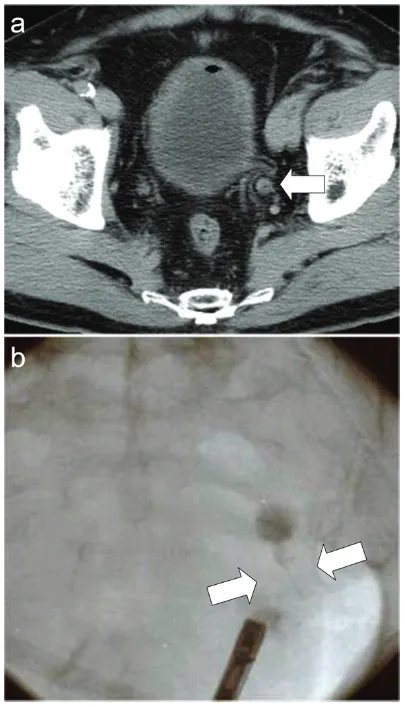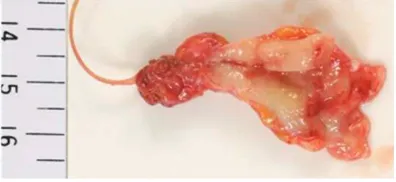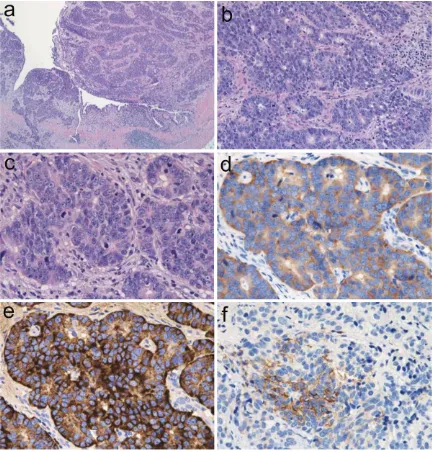Case Report
Primary large cell neuroendocrine carcinoma of the
ureter
Hisashi Oshiro1, Yu Odagaki2, Hiroaki Iobe1, Chouichirou Ozu2, Issei Takizawa2, Takeshi Nagai1, Jun Matsubayashi1, Atsushi Inagaki1, Shinji Miyake1, Toshitaka Nagao1
Departments of 1Pathology and 2Urology, Tokyo Medical University Hospital, Tokyo, Japan
Received January 1, 2013; Accepted February 3, 2013; Epub March 15, 2013; Published April 1, 2013
Abstract: Large cell neuroendocrine carcinoma (LCNEC) is the rarest type of urinary tract malignancy. Herein, we report a case of LCNEC that arose in the ureter of a 78-year-old Japanese man with a history of ascending colon can-cer that had been excised by a right hemicolectomy. Left-sided hydronephrosis associated with the ureteral tumor was discovered during follow-up. A left nephroureterectomy combined with a partial resection of the urinary bladder was performed because atypical cells were detected using voided urine cytology. A histopathological examination revealed that the ureteral tumor contained large atypical epithelial cells of neuroendocrine morphology without a urothelial carcinomatous component. The neoplastic cells were immunohistochemically positive for synaptophysin, chromogranin A, CD56, and cytokeratins, but they were negative for uroplakin III and thyroid transcription factor-1. The Ki-67 labeling index of the neoplastic cells was 50%. Transmission electron microscopy demonstrated the pres-ence of numerous dense granules in the cytoplasm of the neoplastic cells. The ureteral lesion was finally classified as stage III, pT3 cN0 cM0. The patient’s postoperative course was uneventful without chemoradiotherapy, and LCNEC did not recur in the subsequent nine months. This case demonstrates that LCNEC can occur in the ureter, which normally does not contain neuroendocrine cells in the urothelium.
Keywords: Colon cancer, immunohistochemistry, large cell neuroendocrine carcinoma, transmission electron microscopy, ureter, voided urine cytology
Introduction
Primary large cell neuroendocrine carcinoma (LCNEC) of the urinary tract is an extremely rare neoplasm. Given its rarity, the risk factors, bio-logical properties, and effective therapeutic strategies for LCNEC have yet to be determined. LCNECs originate almost exclusively in the uri-nary bladder [1-17], although they also have been reported, in rare instances, to occur in the kidney [18-20]. To the best of our knowledge, a primary LCNEC of the ureter has not been reported in the literature. Herein, we report the first case of a primary LCNEC of the ureter and focus on the clinicopathological findings. Materials and methods
Review of clinical data
The patient’s clinical information was obtained from the medical record and was reviewed by the attending urologists.
Pathological examination
The cells collected from voided urine samples provided during the workups were stained with Papanicolaou stain.
The excised left ureteral tumor was fixed in 20% neutral buffered formalin and embedded in par-affin, and tissue sections were subsequently prepared for pathological examination.
CK7 (OV-TL 12/30; Dako Japan), CK19 (RCK108; Dako Japan), CK20 (Ks 20.8; Dako Japan), synaptophysin (rabbit polyclonal; Dako Japan), chromogranin A (DAK-A3; Dako Japan), CD56 (1B6; Nichirei Biosciences; Tokyo, Japan), uroplakin III (AU1; Progen Biotechnik; Heidelberg, Germany), thyroid transcription fac-tor-1 (8G7G3/1; Dako Japan), carcinoembryon-ic antigen (CEA) (rabbit polyclonal; Dako Japan), p53 (DO7; Dako Japan), and Ki-67 (MIB-1; Dako Japan).
We performed transmission electron microsco-py on a formalin-fixed, paraffin-embedded specimen of the ureteral tumor. The specimen was deparaffinized using xylene and hydrated using a graded series of ethanol. It was then fixed with 1% osmium tetroxide in 0.1 M
phos-Immunohistochemistry was also performed on samples of the patient’s previous ascending colon cancer to enable a comparison with the current ureteral tumor.
Results
Clinical findings
[image:2.612.88.290.70.423.2]A 78-year-old Japanese man with a history of ascending colon cancer that had been treated by a right hemicolectomy was hospitalized due to left hydronephrosis. Prior to this hospital admission, he had been followed-up for 14 months without a remarkable episode. His fam-ily and occupational histories were unremark-able. He did not drink alcohol but had been a smoker for approximately 50 years (Brinkman index 500). At the time of admission to the hos-pital, the results of his general physical exami-nation, complete blood count, and biochemis-try were within normal ranges. His voided urine was slightly turbid but not bloody. Light micro-scopic observation of the urine sediment revealed one to four red blood cells per high power field (HPF), more than 50 white blood cells per HPF, one to four squamous cells per HPF, no urothelial or tubular epithelial cells per HPF, and only a few bacteria per HPF. A mid-stream urine sample contained more than 105 colony-forming units/mL of Streptococcus sp.. Computed tomography of the pelvis revealed a left ureteral tumor (Figure 1A), and retrograde urography demonstrated an obstruction of the lower portion of the left ureter (Figure 1B). A systematic radiographic examination revealed no additional neoplastic lesions other than the left ureteral tumor. A left nephroureterectomy and a partial resection of the urinary bladder were performed, and the ureteral tumor was submitted for pathology. The patient was not given chemoradiotherapy. His postoperative
course was uneventful, and the ureteral tumor did not recur in the subsequent nine months.
Pathological findings
[image:3.612.94.523.72.225.2]The voided urine cytology performed before the nephroureterectomy revealed the presence of small numbers of atypical cells among numer-ous necrotic cells and inflammatory cells (Figure 2). Although highly degenerated, the atypical cells exhibited hyperchromatic pat-terns in nuclei of various sizes. A subset of the atypical cells possessed a relatively rich cyto-plasm and marginally situated nuclei, whereas other cells presented as naked nuclei. These naked nuclei were observed to be round, oval, or polygonal. The relatively well-preserved neo-plastic cells displayed a fine or coarse granular pattern of nuclear chromatin and occasionally had an enlarged nucleolus. In contrast, the poorly preserved neoplastic cells exhibited a
dark blue diffuse pattern of chromatin, incon-spicuous nucleoli, and a relatively high nucleus to cytoplasm ratio with karyopyknotic changes. Nuclear molding and rosette arrangements were seldom observed, and no mitotic figures were detected among the few atypical cells. These cytological findings were characteristic of the malignant cells of adenocarcinomas or urothelial carcinomas, but they were insuffi-cient to render a diagnosis of neuroendocrine carcinoma.
A gross examination of the ureteral tumor excised by nephroureterectomy revealed a ses-sile mass, which measured approximately 23 x 20 x 6 mm, attached to a thickened region of the ureteral wall situated in the lower portion of the left ureter (Figure 3).
[image:3.612.90.288.302.393.2]Histologically, the ureteral tumor contained abundant atypical epithelial cells, some of which had penetrated the muscular layer (Figure 4A). The neoplastic cells occurred in rosette-like, palisading, trabecular, or organoid patterns (Figure 4B). The neoplastic cells, which were characterized by a rich cytoplasm and enlarged nuclei with fine or coarse granular patterns of nuclear chromatin and enlarged nucleoli, were accompanied by mitotic cells and apoptotic bodies (Figure 4C). The average mitotic count was 42 per 10 HPF, and small necrotic foci were observed within the nests of tumor cells. The neoplastic cells were observed to spread in a small region of the ureter in situ, but dysplasia was not evident. Neither urothe-lial carcinoma nor squamous cell carcinoma
Figure 2. Photomicrographs of cells from the voided urine. A: Degenerating, incohesive atypical cells of various sizes containing hyperchromatic nuclei of various sizes are present (Papanicolaou stain; the scale bar indicates 10 µm). B: Neoplastic cells exhibit a relatively rich cytoplasm and a marginally situated nucleus containing fine or coarse granular hyperchromatic material and an enlarged nucleolus (Papanicolaou stain; the scale bar indicates 10 µm).
was observed in the neoplastic lesion. Alcian blue and periodic acid-Schiff double-staining detected glandular structures that accounted for less than 2% of the neoplasm. Minimal lym-phovascular invasion was observed, and the surgical margins were entirely negative.
[image:4.612.90.524.71.523.2]Immunohistochemistry showed that the ureter-al neoplastic cells were positive for synaptophy-sin (Figure 4D), chromogranin A (Figure 4E), CD56 (Figure 4F), epithelial membrane anti-gen, pan-CK, CK7, CK19, CK20, and CEA, but these cells were negative for uroplakin III and
thyroid transcription factor-1. The p53-positive rate was approximately 90%, and Ki-67 label-ing index was approximately 50%.
Transmission electron microscopy of the tumor revealed numerous electron-dense granules with diameters of 200 to 400 nm in the cyto-plasm of neoplastic cells, which resembled neuroendocrine granules (Figure 5).
A pathological review of the patient’s prior ascending colon cancer confirmed the diagno-sis of a moderately differentiated tubular ade-nocarcinoma with negative surgical margins that was classified as Stage IIA, pT3 pN0 cM0, R0 according to the TNM classification system for malignant tumors (7th edition of the International Union against Cancer). Characteristically, true glandular structures with intracytoplasmic mucin were prevalent in the ascending colon cancer, which was nega-tive for synaptophysin, chromogranin A, CD56, uroplakin III, and CK7, as shown in Table 1. The final diagnosis of the ureteral tumor was primary LCNEC of the ureter, which was classi-fied as stage III, pT3 cN0 cM0.
Discussion
LCNEC is a malignant neoplasm consisting of large epithelial cells with neuroendocrine fea-tures [21]. Originally established as a distinct clinicopathologic entity of lung tumors [22], pri-mary LCNECs have since been reported in vari-ous organs. However, LCNEC is the rarest type of urinary tract malignancy. Indeed, only 25 cases have been reported to date, of which 21 were in the bladder [1-17] and four were in the
kidney [18-20]. To the best of our knowledge, there have been no published reports of LCNEC in the ureter.
The clinical presentations of LCNEC in the uri-nary tract have varied from case to case, but hematuria has been the most commonly reported symptom of LCNEC in the bladder [1-17]. For cases of LCNEC in the kidney, the symptoms have been shown to depend on the extent of spread or dissemination of the neo-plasm [18-20]. This type neoneo-plasm tends to show aggressive behavior, and distant metas-tases have been discovered at the time of diag-nosis in the majority of LCNEC cases in the bladder and kidney. Although the data are lim-ited, organ-confined cases are expected to have good prognoses from surgical resection alone or in combination with chemotherapy or radiotherapy.
Diagnoses of primary urinary tract LCNEC are based on the criteria proposed for pulmonary LCNECs, which include the following: (1) a neu-roendocrine morphology (organoid nesting, palisading, rosettes, or trabeculae); (2) a high mitotic rate: 11 or more mitotic cells per 2 mm2 (10 HPF), with a median of 70 mitotic cells per 2 mm2 (10 HPF); (3) necrosis (often a large necrotic zone); (4) the cytologic features of a non-small cell carcinoma, including large cell size; a low ratio of nucleus to cytoplasm, and nuclei with vesicular, coarse or fine chromatin, and/or frequent nucleoli. Some of these tumors contain cells with diffuse nuclear chromatin and no nucleolus, but these tumors still qualify as non-small cell carcinomas because of the presence of large cells with abundant
[image:5.612.91.524.71.207.2]and cytoplasmic morphology. The nuclei are usually centrally located and have thick, rough nuclear membranes, easily identifiable nucleo-li, and irregularly distributed chromatin. Immunohistochemically, urothelial carcinomas are generally positive for uroplakin but not for neuroendocrine markers. The ureteral tumor in the current case did not exhibit the characteris-tic features of high-grade urothelial carcinoma. One might have misinterpreted the present case of ureteral LCNEC as a metastatic or pri-mary adenocarcinoma because of the pres-ence of glandular or pseudoglandular struc-tures. However, the morphological and immunohistochemical findings of the patient’s prior ascending colon cancer were distinct from those of the ureteral tumor, and thus it is highly unlikely that the ureteral LCNEC was derived
nuclear chromatin and absent or faintly observed nucleoli, and (4) a high mitotic rate (11 or more mitotic cells per 2 mm2 (10 HPF), with a median of 80 mitotic cells per 2 mm2, and (5) frequent necro-sis, often in large zones [21]. Using these criteria, train-ed pathologists can distinguish small cell carcinoma from LC- NEC.
In general, neoplas-tic cells in high-grade urothelial car-cinomas exhibit a high degree of varia-tion in size, shape, plasm; and (5) positive immunohistochemical
staining for one or more neuroendocrine mark-ers (other than neuron-specific enolase) and/or the presence of neuroendocrine granules iden-tified by electron microscopy. The present case fulfills all of these diagnostic criteria.
The differential diagnoses for primary LCNECs of the urinary tract included carcinoid tumor, small cell carcinoma, high-grade urothelial car-cinoma, and poorly differentiated adenocar- cinoma.
Education, Culture, Sports, Science and Technology of Japan (No. 24590242 to H. Oshiro and No. 24700501 to T. Nagai).
Address correspondence to: Dr. Hisashi Oshiro, Department of Pathology, Tokyo Medical University Hospital, 6-7-1 Nishi-shinjuku, Shinjuku-ku, Tokyo 160-0023, Japan. Tel: 3-3342-6111; Fax: +81-3-3342-2063; E-mail: oshiroh@yokohama-cu.ac.jp
References
[1] Abenoza P, Manivel C and Sibley RK. Adenocar-cinoma with neuroendocrine differentiation of the urinary bladder. Clinicopathologic, immu-nohistochemical, and ultrastructural study. Arch Pathol Lab Med 1986; 110: 1062-1066. [2] Hailemariam S, Gaspert A, Komminoth P,
Tam-boli P and Amin M. Primary, pure, large-cell neuroendocrine carcinoma of the urinary blad-der. Mod Pathol 1998; 11: 1016-1020. [3] Evans AJ, Al-Maghrabi J, Tsihlias J, Lajoie G,
Sweet JM and Chapman WB. Primary large cell neuroendocrine carcinoma of the urinary blad-der. Arch Pathol Lab Med 2002; 126: 1229-1232.
[4] Dundr P, Pesl M, Povysil C, Vitkova I and Dvora-cek J. Large cell neuroendocrine carcinoma of the urinary bladder with lymphoepithelioma-like features. Pathol Res Pract 2003; 199: 559-563.
[5] Vincendeau S, de Lajarte-Thirouard AS, Ben-salah K, Guille F, Lobel B and Patard JJ. [Neuro-endocrine differentiation of bladder tumors]. Prog Urol 2003; 13: 375-384.
[6] Li Y, Outman JE and Mathur SC. Carcinosarco-ma with a large cell neuroendocrine epithelial component: first report of an unusual biphasic tumour of the urinary bladder. J Clin Pathol 2004; 57: 318-320.
[7] Quek ML, Nichols PW, Yamzon J, Daneshmand S, Miranda G, Cai J, Groshen S, Stein JP and Skinner DG. Radical cystectomy for primary neuroendocrine tumors of the bladder: the uni-versity of southern california experience. J Urol 2005; 174: 93-96.
[8] Lee KH, Ryu SB, Lee MC, Park CS, Juhng SW and Choi C. Primary large cell neuroendocrine carcinoma of the urinary bladder. Pathol Int 2006; 56: 688-693.
[9] Trimeche M, Mutijima E, Ziadi S, Mestiri S, Sor-ba NB, Sriha B, MosSor-bah AT and Korbi S. [Pri-mary large-cell neuro-endocrine carcinoma of the bladder]. Prog Urol 2006; 16: 610-612. [10] Alijo Serrano F, Sanchez-Mora N, Angel Arranz
J, Hernandez C and Alvarez-Fernandez E. Large cell and small cell neuroendocrine bladder car-cinoma: immunohistochemical and outcome
from a metastasis of the ascending colon can-cer. In the ureteral tumor, true glandular struc-tures were observed only in foci, whereas cells positive for neuroendocrine markers were widely observed throughout the neoplastic pop-ulation, including in the glandular structures. These findings suggest that the neoplastic neu-roendocrine cells in the tumor exhibit some glandular alterations, not that the tumor is a poorly differentiated adenocarcinoma.
Because most urinary LCNEC cases present at advanced stages, developing methods for early detection remains a high priority issue. Voided urine cytology can be one of the diagnostic modalities for early detection. However, only one case report has successfully demonstrat-ed the cytological characteristics of a primary LCNEC of the bladder using cells obtained from a voided urine sample [14]. Diagnosing LCNEC by conventional urine cytology alone is difficult because neoplastic cells are highly susceptible to degeneration in urine, as was observed in the present case.
The histogenesis of LCNEC in the urinary tract remains to be elucidated. However, at least two hypotheses have been proposed regarding the origin of LCNEC of the urinary tract. First, it has been suggested that these tumors derive from neuroendocrine cells that are susceptible to oncogenesis and are situated in the normal urothelial mucosa. Alternatively, it has been proposed that LCNECs derive from genetically unstable progenitor cells or pluripotent stem cells [24]. Because neuroendocrine cells are not found in the urothelium of the normal ureter [25], the latter concept appears more feasible for the current case.
In summary, the present case study demon-strates that LCNEC can occur in the ureter, which does not normally contain neuroendo-crine cells in the urothelium. Further investiga-tions are required to clarify the biological prop-erties of these tumors and to develop effective therapeutic strategies.
Conflict of interest statement
We declare that we have no conflict of interest regarding this study.
Financial/nonfinancial disclosures
Lung, Pleura, Thymus and Heart. Lyon: IARC Press; 2004. pp: 19-20.
[22] Travis WD, Linnoila RI, Tsokos MG, Hitchcock CL, Cutler GB Jr, Nieman L, Chrousos G, Pass H and Doppman J. Neuroendocrine tumors of the lung with proposed criteria for large-cell neuroendocrine carcinoma. An ultrastructural, immunohistochemical, and flow cytometric study of 35 cases. Am J Surg Pathol 1991; 15: 529-553.
[23] Rindi GAR, Bosman FT, Capella C, Klimstra DS, Kloppel G, Komminoth P, Solcia E. Nomencula-ture and classification of neuroendocrine neo-plasms of the digestive system. In: Bosman FT, Carneiro F, Hruban RH, Theise ND. Theise, edi-tors. World Health Organization Calssification of Tumours of the Digestive System. Lyon: IARC Press; 2010. pp: 13-14.
[24] Oshiro H, Matsuo K, Mawatari H, Inayama Y, Yamanaka S, Nagahama K, Endo I, Shimada H, Nakajima A and Kubota K. Mucin-producing gallbladder adenocarcinoma with focal small cell and large cell neuroendocrine differentia-tion associated with pancreaticobiliary maljunction. Pathol Int 2008; 58: 780-786. [25] Fetissof F, Dubois MP, Lanson Y and Jobard P.
Endocrine cells in renal pelvis and ureter, an immunohistochemical analysis. J Urol 1986; 135: 420-421.
Moon KC and Koh JK. Cutaneous metastasis from large-cell neuroendocrine carcinoma of the urinary bladder expressing CK20 and TTF-1. Am J Dermatopathol 2009; 31: 166-169. [14] Oshiro H, Gomi K, Nagahama K, Nagashima Y,
Kanazawa M, Kato J, Hatano T and Inayama Y. Urinary cytologic features of primary large cell neuroendocrine carcinoma of the urinary blad-der: a case report. Acta Cytol 2010; 54: 303-310.
[15] Tsugu A, Yoshiyama M and Matsumae M. Brain metastasis from large cell neuroendocrine car-cinoma of the urinary bladder. Surg Neurol Int 2011; 2: 84.
[16] Martin IJ, Vilar DG, Aguado JM, Perello CG, Ali-aga MR, Argente VG, Ferreres LA and Gomez JG. Large cell neuroendocrine carcinoma of the urinary bladder. Bibliographic review. Arch Esp Urol 2011; 64: 105-113.
[17] Engles CD, Slobodov G, Buethe DD, Lightfoot S and Culkin DJ. Primary mixed neuroendocrine carcinoma of the bladder with large cell com-ponent: a case report and review of the litera-ture. Int Urol Nephrol 2012; 44: 1021-1025. [18] Moukassa D, Leroy X, Bouchind’homme B,



